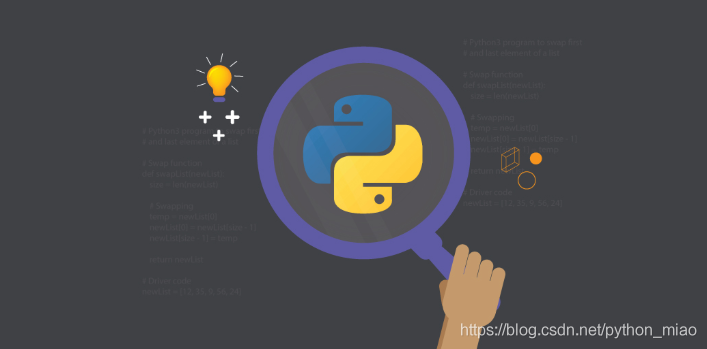今天看了篇文章总结了 40 种Python String 类型的常用语法,觉着很有趣,翻译重新整理分享给大家。尽管有些语法你可能用不到,但也算是掌握一种奇思巧技。
1/ 创建字符串
s1 = 'This is a test.'
复制代码2/ 使用 print 语句查看输出
# python3/python2
>>> print('this is a test.')
this is a test.
# python3/python2
>>> print ('test')
test
# python2
>>> print '123'
123
复制代码
如果大家在学习中遇到困难,想找一个python学习交流环境,可以加入我们的python圈,裙号930900780,可领取python学习资料,会节约很多时间,减少很多遇到的难题。
3/ 单行查看输出
>>> s1 = 'this is'
>>> s2 = ' a test'
>>> print(s1+s2)
this is a test
复制代码4/ 单行 \n 查看输出
>>> print(s1+'\n'+s2)
this is
a test
复制代码5/ 字符串下标表示法
>>> print(s1[0])
t
>>> print(s1[1])
h
>>> print(s1[8])
Traceback (most recent call last):
File "<input>", line 1, in <module>
IndexError: string index out of range
复制代码6/ 下标字符串相加
>>> print(s1[1]+s1[3]+s1[4])
hs
复制代码7/ 切片字符串
>>> print(s1[0:5])
this
>>> print(s1[0:])
this is
>>> print(s1[:])
this is
>>> print(s1[:-1])
this i
>>> print(s1[::2])
ti s
复制代码8/ 负索引切片
>>> print(s1[-5:-1])
is i
>>> print(s1[-1::-1]) # 反转字符串
si siht
复制代码9/ %格式化操作符
>>> print('this is a %s' % 'test')
this is a test
>>> print('this is a %(test)s' % {'test':'12345'})
this is a 12345
复制代码10/ 带整数的%
>>> print('1+1 = %(num)01d' % {'num': 2})
1+1 = 2
>>> print('1+1 = %(num)02d' % {'num': 2})
1+1 = 02
>>> print('1+1 = %(num)03d' % {'num': 2})
1+1 = 002
复制代码11/ %用于站位
>>> print( '%(a)s %(n)03d - program is the best.' % {'a':'Python','n':3})
Python 003 - program is the best.
复制代码12/ 利用 \n 分拆字符串
>>> print(' %(a)s %(n)03d - program is the best \n %(a)s helped me understand programming.' % {"a":"Python","n":3})
Python 003 - program is the best
Python helped me understand programming.
复制代码13/ 多个\n
>>> print(' I love %(a)s. \n I like %(b)s. \n I like to %(c)s. \n my %(d)s is %(num)03d.'%{"a":"to code","b":"ice-cream","c":"travel","d":"age","num":32})
I love to code.
I like ice-cream.
I like to travel.
my age is 032.
复制代码14/ 其他方式使用%
>>> print('Hello everyone I am using Python %d.7 version.' % 3.7)
Hello everyone I am using Python 3.7 version.
>>> print('%s %s %d %d %f %f' % ('Hercules', 'Zeus', 100, 20, 3.2, 1))
Hercules Zeus 100 20 3.200000 1.000000
>>> print('This is a +%d integer' % 10)
This is a +10 integer
>>> print('This is a negative -%d integer' % 250)
This is a negative -250 integer
>>> print('This is a confused -%d integer' % 300)
This is a confused -300 integer
复制代码15/ 字串符转为整数
>>> s3 = '123'
>>> print(10*int(s3)) # 乘法
1230
>>> print(10*s3) # 倍数
123123123123123123123123123123
>>> print('1'+'45')
145
>>> print('1'+45)
Traceback (most recent call last):
File "<stdin>", line 1, in <module>
TypeError: can only concatenate str (not "int") to str
>>> print(float('1')+float('45'))
46.0
复制代码16/ 获取单个字符在字符串中出现的次数
>>> text = 'this is a test.'
>>> print(text.count('t'))
3
>>> print(text.count('is'))
2
复制代码17/ 将字符串变为大写
>>> text = 'this is a test.'
>>> print(text.upper())
THIS IS A TEST.
复制代码18/ 将字符串变为小写
>>> text = 'THIS IS A TEST.'
>>> print(text.upper())
this is a test.
复制代码19/ 组合字符串
>>> ' '.join(text)
't h i s i s a t e s t .'
>>> ','.join(['hello', 'Dean'])
'hello,Dean'
复制代码20/ 分拆字符串
>>> text = 'this is a test.'
>>> print(text.split(' '))
['this', 'is', 'a', 'test.']
复制代码21/ 判断字符串是否是大写
>>> text
'this is a test.'
>>> up_text = text.upper()
>>> print(up_text.isupper())
True
复制代码22/ 判断字符串是否是小写
>>> low_text = text.lower()
>>> print(low_text.islower())
True
复制代码23/ 判断字符串是否有字母数字构成
>>> text1 = 'Lession 01'
>>> print(text1.isalnum())
False
>>> text2 = 'Lession01'
>>> print(text2.isalnum())
True
复制代码24/ 获取字符串的长度
>>> text
'this is a test.'
>>> print(len(text))
15
复制代码25/ 将字符串转化为 10 进制的 asscii 码
>>> print(ord('A'))
65
>>> print(ord('B'))
66
>>> print(ord('a'))
97
>>> print(ord('b'))
98
复制代码26/ 将 10 进制的 asscii 码转化为字符串
>>> print(chr(65))
A
>>> print(chr(42))
*
>>> print(chr(118))
v
>>> print(chr(60))
<
复制代码27/ 转义字符
>>> print('What\'s up?')
What's up?
>>> # the apostrophe is not needed in this case.
>>> print("What's up?")
What's up?
>>> # the apostrophe is needed to add on the quotes to the text
>>> print("\"What's up?\"")
"What's up?"
>>> # triple quotes can escape single, double, and a lot more.
>>> print("""What's up? Does the "" need an escape?""")
What's up? Does the "" need an escape?
复制代码28/ 使用逗号格式化字符串
>>> print('这里有', 10, '个苹果')
这里有 10 个苹果
复制代码29/ format 格式化字符串
>>> text
'this is a test.'
>>> print('This is a {}'.format(text))
This is a this is a test.
>>> print('Number {1} and number {0}'.format(100, 200)) # keyword position
Number 200 and number 100
复制代码30/ format 中通过名字传递字符
>>> print('这里有{num}个{type}。'.format(num=10, type='苹果'))
这里有10个苹果。
>>> tmp = {'num': 10, 'type': '苹果'}
>>> print('这里有{num}个{type}。'.format(**tmp))
这里有10个苹果。
复制代码31/ format 中通过参数顺序传递字符
>>> print('这里有{1}个{0}。'.format('苹果',10))
这里有10个苹果。
复制代码32/ format 中访问对象属性
>>> class Rectangle:
def __init__(self, length, width):
self.length = length
self.width = width
def __str__(self):
return 'Rectangle({self.length}, {self.width})'.format(self=self)
>>> rect = Rectangle(10, 5.5)
>>> print(rect.__str__())
Rectangle(10, 5.5)
复制代码33/ 对齐文本
>>> print('{:<10}'.format('X')) # left align
X
>>> print('{:>10}'.format('X')) # right align
X
>>> print('{:^10}'.format('X')) # center
X
>>> print('{:?^10}'.format('X')) # add a fill character
????X?????
复制代码34/ 格式化二进制、八进制和十六进制
>>> print('Binary number: {0:b}'.format(50))
Binary number: 110010
>>> print('Octal number: {0:o}'.format(100))
Octal number: 144
>>> print('Hexadecimal number: {0:x}'.format(2555))
Hexadecimal number: 9fb
复制代码35/ 使用逗号作为分隔符
>>> print('{:,}'.format(2783727282727))
2,783,727,282,727
>>> print('{:.2%}'.format(90.60/100))
90.60%
复制代码36/ 使用f来格式化字符串
>>> item_1, item_2, item_3 = 'computer', 'mouse', 'browser'
>>> print(f"He uses a {item_1}.")
He uses a computer.
>>> print(f"He uses a {item_2} and a {item_3}.")
He uses a mouse and a browser.
>>> print(f"He uses a {item_1} 3 times a day.")
He uses a computer 3 times a day.
复制代码37/ 使用模板格式化字符串
# docs: https://docs.python.org/3/library/string.html#template-strings
>>> from string import Template
>>> poem = Template('$x are red and $y are blue')
>>> print(poem.substitute(x='roses', y='violets'))
roses are red and violets are blue
复制代码38/ 字符串的遍历
>>> text
'this is a test.'
>>> for item in text:
... print(item)
...
t
h
i
s
i
s
a
t
e
s
t
.
复制代码39/ 使用 while 循环
>>> i = 0
>>> while i < len(text):
print(text[i])
复制代码40/ 使用三引号保存字符串
>>> def triple_quote_docs():
"""
In the golden lightning
Of the sunken sun,
O'er which clouds are bright'ning,
Thou dost float and run,
Like an unbodied joy whose race is just begun.
"""
return
>>> print(triple_quote_docs.__doc__)
In the golden lightning
Of the sunken sun,
O'er which clouds are bright'ning,
Thou dost float and run,
Like an unbodied joy whose race is just begun.
>>>最后多说一句,小编这里整理了一套最新的python系统学习教程,包括从基础的python脚本到web开发、爬虫、数据分析、数据可视化、机器学习等。想要这些资料的可以进q裙930900780领取。
本文章素材来源于网络,如有侵权请联系删除。
版权声明:本文为python_miao原创文章,遵循CC 4.0 BY-SA版权协议,转载请附上原文出处链接和本声明。